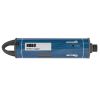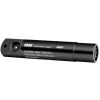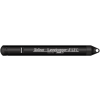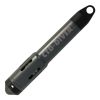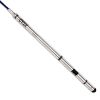HOBO Fresh Water Conductivity Logger
Features
- Non-contact sensor provides long life and less measurement drift
- Provides easy access to sensor for cleaning and shedding air bubbles
- Requires HOBOware Pro Software and optic base station or waterproof shuttle
- Free ground shipping
- Expedited repair and warranty service
- Lifetime technical support
- More
Overview
The Onset HOBO U24 high-accuracy conductivity data logger is a cost-effective way to collect water quality data. The HOBO U24 measures and records both conductivity and temperatures in streams, lakes, and other freshwater sources. The Onset HOBO U24 logger is recommended for monitoring aquifers for saltwater intrusion and road and agricultural runoff. This product’s open access to its sensor simplifies cleaning and maintenance. The U24’s non-contact sensor minimizes measurement errors related to drift and features software-based drift compensation.
Low-Maintenance
The HOBO U24 Conductivity data logger features a non-contact sensor with a Titanium Pentoxide coating. This coating prevents the sensor from coming in contact with the water, which in turn prevents tarnishing or corrosion associated with traditional electrode sensors. This sensor coating is also inert, enabling fouling to be easily wiped off the sensor.
| Measurements | Actual Conductivity, Temperature, Specific Conductance at 25°C (calculated) |
| Conductivity Calibrated Measurement Ranges | Low Range: 0 to 1,000 µS/cm Full Range: 0 to 10,000 µS/cm |
| Conductivity Calibrated Range - Temperature Range | 5° to 35°C (41° to 95°F) |
| Conductivity Extended Ranges | Low Range: 0 to 2,500 µS/cm Full Range: 0 to 15,000 µS/cm |
| Temperature Measurement Range | -2° to 36°C (28° to 97°F) |
| Specific Conductance Accuracy (in Calibrated Range) | Low Range: 3% of reading, or 5 µS/cm, and Full Range: 3% of reading, or 20 µS/cm, whichever is greater, using Conductivity Data Assistant and calibration measurements |
| Conductivity Resolution | 1 µS/cm |
| Temperature Accuracy | 0.1°C (0.2°F) at 25°C (77°F) |
| Temperature Resolution | 0.01°C (0.02°F) |
| Conductivity Drift | Less than 3% sensor drift per year, exclusive of drift from fouling |
| Response Time | 1 second to 90% of change (in water) |
| Operating Range | -2° to 36°C (28° to 97°F) - non-freezing |
| Memory | 18,500 temperature and conductivity measurements when using one conductivity range; 11,500 sets of measurements when using both conductivity ranges (64 KB total memory) |
| Sample Rate | 1 second to 18 hrs, fixed or multiple-rate sampling with up to 8 user-defined sampling intervals |
| Clock Accuracy | ±1 minute per month |
| Battery | 3.6 Volt lithium battery |
| Battery Life | 3 years (at 1 minute logging) |
| Maximum Depth | 70 m (225 ft) |
| Weight | 193 g (6.82 oz), buoyancy in freshwater: -59.8 g (-2.11 oz) |
| Size | 3.18 cm diameter x 16.5 cm, with 6.3 mm mounting hole (1.25 in. diameter x 6.5 in., 0.25 in. hole) |
| Wetted Housing Materials | Delrin®, epoxy, stainless steel retaining ring, polypropylene, Buna rubber O-ring, titanium pentoxide (inert coating over sensor) |
| Environmental Rating | IP68 |
- HOBO U24-001 Conductivity Data Logger
- Communications window protective cap
In The News
Research in the Reserve: Promoting Interdisciplinary Conservation at the Great Bay National Estuarine Research Reserve
On an early winter day in 1973, a helicopter buzzed over Durham, New Hampshire, just a few miles from the Atlantic Ocean. One of the helicopter’s guests, oil magnate Aristotle Onassis, owner of Olympic Refining, looked east of town and saw what he hoped would become the world’s largest oil refinery. Instead, he saw the Great Bay; thousands of acres of green coastal forest, mud flats, salt marshes, and estuarine tidal waters stretching over the land toward New Hampshire's small Eastern coastline. Onassis likely also saw a group of Durham residents staked out on the bay’s coast, ready for him to pass overhead. While out of place in the natural setting, an obvious message was spelled out in red paper: “Not Here.
Read MoreFloating Global New Ideas: Buoy-Enabled Research at Florida Agricultural and Mechanical University’s School of the Environment
Florida Agricultural and Mechanical University (FAMU), based in Tallahassee, Florida, is the highest-rated public Historically Black College or University in the United States. FAMU’s School of the Environment (FAMU-SOE) offers BS and BA degrees in Environmental Studies, and BS, MS, and Ph.D. degrees in Environmental Science, with specialisms available in areas including Environmental Policy and Risk Management, Aquatic and Terrestrial Ecology, and Biomolecular Sciences. In 2021, FAMU-SOE deployed a NexSens CB-450 buoy in Apalachee Bay, a key oyster farming area around 30 miles south of Tallahassee. The buoy has quickly been incorporated into the curriculum, providing environmental insights for student research, the community, and beyond. Dr.
Read MoreMonitoring Habitat Suitability and Water Quality in Northwest Arkansas Springs
Northwest Arkansas has seen an economic, industrial, and population boom in recent years as a result of expanding businesses, which have created thousands of jobs in the region and the mass migration of employees and construction companies. However, with this growth has come rapid urbanization and the degradation of the natural landscape, specifically the freshwater springs that can be found throughout the region. These springs are critical habitat centers for native wildlife, home to threatened and endangered fish, and those that have yet to be listed. Zach Moran, Assistant Professor of Fisheries Science at Arkansas Technical University, is working to help monitor these habitats and provide key data that will hopefully inform future development in the region.
Read More







